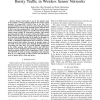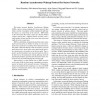66 search results - page 9 / 14 » Reducing Network Energy Consumption via Sleeping and Rate-Ad... |
GLOBECOM
2010
IEEE
13 years 5 months ago
2010
IEEE
Energy conservation is one of the primary goals of the majority of MAC protocols designed for wireless sensor networks. In Sensor-MAC (S-MAC), one of the first MAC protocols design...
TMC
2010
13 years 6 months ago
2010
—Many recent advances in MAC protocols for wireless sensor networks have been proposed to reduce idle listening, an energy wasteful state of the radio. Low-Power-Listening (LPL) ...
BROADNETS
2004
IEEE
13 years 11 months ago
2004
IEEE
This paper presents Random Asynchronous Wakeup (RAW), a power saving technique for sensor networks that reduces energy consumption without significantly affecting the latency or c...
INFOCOM
2010
IEEE
13 years 6 months ago
2010
IEEE
Abstract—We study network optimization that considers energy minimization as an objective. Studies have shown that mechanisms such as speed scaling can significantly reduce the ...
INFOCOM
2010
IEEE
13 years 6 months ago
2010
IEEE
Abstract— MaxWeight algorithm, a.k.a., back-pressure algorithm, has received much attention as a viable solution for dynamic link scheduling in multi-hop wireless networks. The b...


